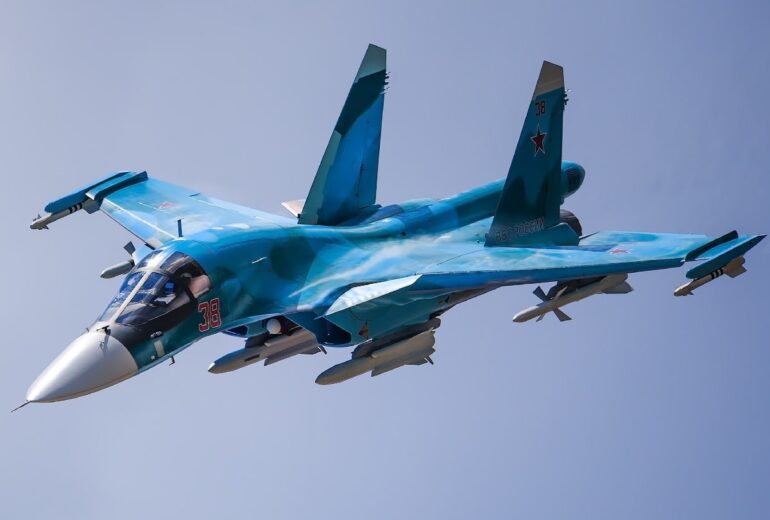TL;DR:
- Russia introduced an AI-ML-based system called Spekle for cockpit glass defect detection in Su-34 fighter aircraft.
- The technology is part of a broader AI integration in Russian military platforms, including the Su-57 and Marker UGV.
- The Su-34, designed for versatile ground attack missions, has seen extensive use, straining maintenance efforts.
- Spekle’s neural network-driven automation streamlines inspections, reducing assessment time to 3-5 minutes.
- The system ensures cockpit glass integrity during flights and enhances overall operational efficiency.
Main AI News:
In the ever-evolving landscape of military aviation, Russia has unveiled a groundbreaking advancement in its arsenal. The Su-34 fighter, a formidable component of the Russian Air Force’s ground attack fleet, has received a significant upgrade in the form of an Artificial Intelligence-Machine Learning (AI-ML) based system. This innovative technology is designed to identify and assess defects in the cockpit glass and its supporting fixtures, which are susceptible to wear and tear due to the aircraft’s intensive operational demands.
Termed “Spekle,” this laser-based device has undergone rigorous testing on the Su-34 fighter-bomber, where its capabilities are proving to be a game-changer. Russia has been progressively integrating AI-powered solutions into its fighter aircraft and ground weapons platforms, marking a significant stride towards enhanced efficiency and autonomous operations.
Among the notable AI-enabled systems introduced are those featured in the Su-57 fifth-generation stealth fighter and the Marker unmanned ground vehicle (UGV). These systems encompass pilot interfaces, communication enhancements, and target identification solutions, elevating the overall capabilities of these formidable machines.
The Su-34, a workhorse of the Russian Air Force, has been relentlessly deployed since the outset of the conflict last year. It has been instrumental in executing high-altitude standoff missile strikes and low-altitude bombing sorties. However, this consistent usage has taken a toll on the aircraft’s structural integrity and placed a substantial burden on maintenance logistics.
The introduction of the Spekle system is poised to address these challenges effectively. This AI-ML device, empowered by neural networks, automates the process of assessing cockpit glass defects, relieving ground crews from laborious and time-consuming inspections. Neural networks, drawing inspiration from the human brain, consist of interconnected processing nodes that facilitate machine learning through the analysis of training examples.
One of the key advantages of this technology is its ability to learn from mistakes while under human supervision. Remarkably, a single aircraft inspection with the Spekle system requires a mere 3-5 minutes, significantly streamlining maintenance procedures.
The Spekle software and hardware complex employ laser beam analysis, coupled with cabin pressurization, to detect glazing defects. As a result, it substantially reduces the risk of cockpit glass deterioration during flight, ensuring the safety and reliability of the Su-34 aircraft.
The Su-34 front-line bomber, designed for versatility, is capable of engaging ground, surface, and air targets around the clock, regardless of weather conditions. With a two-person crew and the ability to carry up to eight tons of weaponry on 12 external hardpoints, including various guided missiles and aerial bombs, it epitomizes Russia’s commitment to modernizing its air force.
In recent operations in the Northern Military District zone, the Su-34 has played a pivotal role in striking tactical Ukrainian targets, including manpower concentrations, temporary deployment points, ammunition depots, and AFU reserve concentrations, using precision-guided munitions.
This fighter aircraft stands as the cornerstone of the Russian Air Force’s battlefield standoff strike capabilities, excelling in delivering long-range munitions while avoiding exposure to advanced air defense systems. Notably, Russia recently received a fresh batch of Su-34s, reaffirming its dedication to maintaining a formidable and technologically advanced air force.
The Su-34, based on the Sukhoi Su-27 Flanker air superiority fighter, features a sophisticated multi-mode phased array radar system with terrain following and avoidance capabilities, enhancing its prowess in both aerial warfare and bombing missions.
Conclusion:
The incorporation of AI-ML-based systems like Spekle into Russia’s military aviation not only enhances the safety and efficiency of its aircraft but also underscores the nation’s commitment to modernizing its defense infrastructure. This technology could potentially set a precedent for AI integration in the global defense market, highlighting the increasing importance of automation and AI-driven solutions in military operations and maintenance.

